Sustainable Valorization of Posidonia Waste Ash for Phosphate Removal: A Surface Complexation Approach Under Variable Water Chemistry
Abstract
1. Introduction
- Develop and characterize a novel adsorbent material derived from Posidonia oceanica residues for phosphorus removal.
- Establish a thermodynamic modeling approach supported by instrumental techniques.
- Elucidate the dominant phosphate retention mechanisms under variable chemical conditions.
- Validate model predictions and analyze the sensitivity of its parameters.
- Evaluate the potential reuse of the spent material for nutrient recovery via gradual phosphorus release.
2. Results and Discussion
2.1. Adsorbent Characterization
2.1.1. Surface Area and Porosity
2.1.2. Elemental and Chemical Composition
2.1.3. Thermal Stability, Morphology, and Crystalline Structure
2.1.4. Surface Charge Behavior of the Adsorbent
2.2. Phosphate Removal Performance
2.3. Surface Complexation Modeling
2.3.1. Approach and Implementation
2.3.2. Parameter Determination
2.3.3. Phosphorus Speciation and Removal Efficiency
2.3.4. Effect of pH and Alkalinity on Phosphate Removal
2.4. Model Validation
2.4.1. Competitive and Synergetic Effects
2.4.2. Sensitivity Analysis
2.4.3. Surface Analysis After Adsorption
2.5. Phosphorus Release
3. Materials and Methods
3.1. Adsorbent Preparation
3.2. Characterization and Analytical Methods
3.2.1. Adsorbent Characterization
3.2.2. Surface Charge and Point of Zero Charge
3.2.3. Water Analysis
3.3. Batch Experiments
3.3.1. Phosphate Removal
3.3.2. Phosphate Release
3.4. Surface Complexation Modeling
3.5. Model Validation and Sensitivity Analysis
4. Conclusions
Supplementary Materials
Author Contributions
Funding
Institutional Review Board Statement
Informed Consent Statement
Data Availability Statement
Acknowledgments
Conflicts of Interest
Abbreviations
| AAS | Atomic Absorption Spectroscopy |
| EDS | Energy-Dispersive X-Ray Spectroscopy |
| FTIR | Fourier-Transform Infrared Spectroscopy |
| HAP | Hydroxyapatite |
| ICP | Inductively Coupled Plasma |
| NEM | Non-Electrostatic Model |
| NMR | Nuclear Magnetic Resonance |
| POA | Posidonia oceanica Ash |
| PZC | Point of Zero Charge |
| SCM | Surface Complexation Model |
| SEM | Scanning Electron Microscopy |
| XRD | X-Ray Diffraction |
References
- Vigiak, O.; Udías, A.; Grizzetti, B.; Zanni, M.; Aloe, A.; Weiss, F.; Hristov, J.; Bisselink, B.; de Roo, A.; Pistocchi, A. Recent Regional Changes in Nutrient Fluxes of European Surface Waters. Sci. Total Environ. 2023, 858, 160063. [Google Scholar] [CrossRef]
- Wilkinson, G.M.; Johnson, R.A. Eutrophication of Freshwater and Coastal Ecosystems. In Encyclopedia of Sustainable Technologies, 2nd ed.; Elsevier: Amsterdam, The Netherlands, 2024; Volume 2, pp. 710–721. ISBN 9780323903868. [Google Scholar]
- Moon, J.; Lee, K.; Tanhua, T.; Kress, N.; Kim, I. Temporal Nutrient Dynamics in the Mediterranean Sea in Response to Anthropogenic Inputs. Geophys. Res. Lett. 2016, 43, 5243–5251. [Google Scholar] [CrossRef]
- Pergent-Martini, C.; Pergent, G.; Monnier, B.; Boudouresque, C.F.; Mori, C.; Valette-Sansevin, A. Contribution of Posidonia Oceanica Meadows in the Context of Climate Change Mitigation in the Mediterranean Sea. Mar. Environ. Res. 2021, 165, 105236. [Google Scholar] [CrossRef]
- Gómez-Pujol, L.; Orfila, A.; Álvarez-Ellacuría, A.; Terrados, J.; Tintoré, J. Posidonia Oceanica Beach-Cast Litter in Mediterranean Beaches: A Coastal Videomonitoring Study. J. Coast. Res. 2013, 65, 1768–1773. [Google Scholar] [CrossRef]
- Mnafki, R.; Morales, A.; Sillero, L.; Khiari, R.; Moussaoui, Y.; Labidi, J. Integral Valorization of Posidonia Oceanica Balls: An Abundant and Potential Biomass. Polymers 2024, 16, 164. [Google Scholar] [CrossRef]
- Restaino, O.F.; Giosafatto, C.V.L.; Mirpoor, S.F.; Cammarota, M.; Hejazi, S.; Mariniello, L.; Schiraldi, C.; Porta, R. Sustainable Exploitation of Posidonia Oceanica Sea Balls (Egagropili): A Review. Int. J. Mol. Sci. 2023, 24, 7301. [Google Scholar] [CrossRef]
- Hashim, K.S.; Ewadh, H.M.; Muhsin, A.A.; Zubaidi, S.L.; Kot, P.; Muradov, M.; Aljefery, M.; Al-Khaddar, R. Phosphate Removal from Water Using Bottom Ash: Adsorption Performance, Coexisting Anions and Modelling Studies. Water Sci. Technol. 2021, 83, 77–89. [Google Scholar] [CrossRef]
- Drapanauskaite, D.; Buneviciene, K.; Silva, M.; Slepetiene, A.; Baltrusaitis, J. Phosphate Removal from Simulated Wastewater Using Industrial Calcium-Containing Solid Waste. J. Environ. Chem. Eng. 2021, 9, 106575. [Google Scholar] [CrossRef]
- Amrutha; Jeppu, G.; Girish, C.R.; Prabhu, B.; Mayer, K. Multi-Component Adsorption Isotherms: Review and Modeling Studies. Environ. Process. 2023, 10, 38. [Google Scholar] [CrossRef]
- VanBriesen, J.M.; Small, M.; Weber, C.; Wilson, J. Modelling Chemical Speciation: Thermodynamics, Kinetics and Uncertainty. Model. Pollut. Complex Environ. Syst. 2010, 2, 133–149. [Google Scholar]
- Goldberg, S. Application of Surface Complexation Models to Anion Adsorption by Natural Materials. Environ. Toxicol. Chem. 2014, 33, 2172–2180. [Google Scholar] [CrossRef]
- Fan, X.; Wu, Y.; He, Y.; Liu, H.; Guo, J.; Li, B.; Peng, H. Efficient Removal of Phosphorus by Adsorption. Phosphorus Sulfur Silicon Relat. Elem. 2023, 198, 375–384. [Google Scholar] [CrossRef]
- Pratt, C.; Soares, A. New Opportunities for Biologically and Chemically Mediated Adsorption and Precipitation of Phosphorus from Wastewater. Curr. Opin. Biotechnol. 2025, 92, 103261. [Google Scholar] [CrossRef]
- Gizaw, A.; Zewge, F.; Kumar, A.; Mekonnen, A.; Tesfaye, M. A Comprehensive Review on Nitrate and Phosphate Removal and Recovery from Aqueous Solutions by Adsorption. AQUA Water Infrastruct. Ecosyst. Soc. 2021, 70, 921–947. [Google Scholar] [CrossRef]
- Ondrasek, G.; Kranjčec, F.; Maltašić, G.; Stipičević, S. Hardwood Fly Ash as a Low-C Waste Has Strong Potential to Become a Value-Added Sorbent for Removal of the Herbicide Terbuthylazine from the Aquatic Matrix. Biomass Convers. Biorefin. 2025, 15, 1911–1923. [Google Scholar] [CrossRef]
- Vassilev, S.V.; Baxter, D.; Vassileva, C.G. An Overview of the Behaviour of Biomass during Combustion: Part II. Ash Fusion and Ash Formation Mechanisms of Biomass Types. Fuel 2014, 117, 152–183. [Google Scholar] [CrossRef]
- Wang, S.; Jiang, X.M.; Han, X.X.; Wang, H. Fusion Characteristic Study on Seaweed Biomass Ash. Energy Fuels 2008, 22, 2229–2235. [Google Scholar] [CrossRef]
- Ighalo, J.O.; Adeniyi, A.G. A Mini-Review of the Morphological Properties of Biosorbents Derived from Plant Leaves. SN Appl. Sci. 2020, 2, 509. [Google Scholar] [CrossRef]
- Harja, M.; Buema, G.; Bulgariu, L.; Bulgariu, D.; Sutiman, D.M.; Ciobanu, G. Removal of Cadmium(II) from Aqueous Solution by Adsorption onto Modified Algae and Ash. Korean J. Chem. Eng. 2015, 32, 1804–1811. [Google Scholar] [CrossRef]
- Lichtfouse, E.; Schwarzbauer, J.; Robert, D. (Eds.) Environmental Chemistry: Green Chemistry and Pollutants in Ecosystems; Springer: Berlin/Heidelberg, Germany, 2004; ISBN 9783540228608. [Google Scholar]
- Ong, G.M.C.; Gallegos, A.; Wu, J. Modeling Surface Charge Regulation of Colloidal Particles in Aqueous Solutions. Langmuir 2020, 36, 11918–11928. [Google Scholar] [CrossRef] [PubMed]
- Stumm, W.; Morgan, J.J. Aquatic Chemistry: Chemical Equilibria and Rates in Natural Waters; John Wiley & Sons: Hoboken, NJ, USA, 2013; ISBN 047167303X. [Google Scholar]
- Sparks, D.L.; Singh, B.; Siebecker, M.G. Environmental Soil Chemistry; Elsevier: Amsterdam, The Netherlands, 2022; ISBN 0443140359. [Google Scholar]
- Khokhotva, O.P.; Westholm, L.J. The Impact of Surface Properties of Modified Pine Bark on the Mechanism of Sorption of Heavy Metals from Aqueous Media. J. Water Chem. Technol. 2017, 39, 148–154. [Google Scholar] [CrossRef]
- Patyal, V.; Jaspal, D.; Khare, K. Materials for Phosphorous Remediation: A Review. Phosphorus Sulfur. Silicon Relat. Elem. 2021, 196, 1025–1037. [Google Scholar] [CrossRef]
- Wahab, M.A.; Ben Hassine, R.; Jellali, S. Posidonia oceanica (L.) fibers as a potential low-cost adsorbent for the removal and recovery of orthophosphate. J. Hazard. Mater. 2011, 191, 333–341. [Google Scholar] [CrossRef] [PubMed]
- Yang, S.; Zhao, Y.; Chen, R.; Feng, C.; Zhang, Z.; Lei, Z.; Yang, Y. A Novel Tablet Porous Material Developed as Adsorbent for Phosphate Removal and Recycling. J. Colloid. Interface Sci. 2013, 396, 197–204. [Google Scholar] [CrossRef] [PubMed]
- Wahab, M.A.; Ben Hassine, R.; Jellali, S. Removal of Phosphorus from Aqueous Solution by Posidonia Oceanica Fibers Using Continuous Stirring Tank Reactor. J. Hazard. Mater. 2011, 189, 577–585. [Google Scholar] [CrossRef]
- Park, J.H.; Ok, Y.S.; Kim, S.H.; Cho, J.S.; Heo, J.S.; Delaune, R.D.; Seo, D.C. Evaluation of Phosphorus Adsorption Capacity of Sesame Straw Biochar on Aqueous Solution: Influence of Activation Methods and Pyrolysis Temperatures. Environ. Geochem. Health 2015, 37, 969–983. [Google Scholar] [CrossRef]
- Jung, K.W.; Hwang, M.J.; Ahn, K.H.; Ok, Y.S. Kinetic Study on Phosphate Removal from Aqueous Solution by Biochar Derived from Peanut Shell as Renewable Adsorptive Media. Int. J. Environ. Sci. Technol. 2015, 12, 3363–3372. [Google Scholar] [CrossRef]
- Takaya, C.A.; Fletcher, L.A.; Singh, S.; Anyikude, K.U.; Ross, A.B. Phosphate and Ammonium Sorption Capacity of Biochar and Hydrochar from Different Wastes. Chemosphere 2016, 145, 518–527. [Google Scholar] [CrossRef] [PubMed]
- Zhao, S.; Wang, B.; Gao, Q.; Gao, Y.; Liu, S. Adsorption of Phosphorus by Different Biochars. Spectrosc. Lett. 2017, 50, 73–80. [Google Scholar] [CrossRef]
- Xu, G.; Zhang, Z.; Deng, L. Adsorption Behaviors and Removal Efficiencies of Inorganic, Polymeric and Organic Phosphates from Aqueous Solution on Biochar Derived from Sewage Sludge of Chemically Enhanced Primary Treatment Process. Water 2018, 10, 869. [Google Scholar] [CrossRef]
- Eduah, J.O.; Nartey, E.K.; Abekoe, M.K.; Henriksen, S.W.; Andersen, M.N. Mechanism of Orthophosphate (PO4-P) Adsorption onto Different Biochars. Environ. Technol. Innov. 2020, 17, 100572. [Google Scholar] [CrossRef]
- Takaya, C.A.; Fletcher, L.A.; Singh, S.; Okwuosa, U.C.; Ross, A.B. Recovery of Phosphate with Chemically Modified Biochars. J. Environ. Chem. Eng. 2016, 4, 1156–1165. [Google Scholar] [CrossRef]
- Li, X.; Shi, J. Simultaneous Adsorption of Tetracycline, Ammonium and Phosphate from Wastewater by Iron and Nitrogen Modified Biochar: Kinetics, Isotherm, Thermodynamic and Mechanism. Chemosphere 2022, 293, 133574. [Google Scholar] [CrossRef]
- Tao, X.; Huang, T.; Lv, B. Synthesis of Fe/Mg-Biochar Nanocomposites for Phosphate Removal. Materials 2020, 13, 816. [Google Scholar] [CrossRef]
- Manjunath, S.V.; Kumar, M. Evaluation of Single-Component and Multi-Component Adsorption of Metronidazole, Phosphate and Nitrate on Activated Carbon from Prosopıs julıflora. Chem. Eng. J. 2018, 346, 525–534. [Google Scholar] [CrossRef]
- Han, T.; Lu, X.; Sun, Y.; Jiang, J.; Yang, W.; Jönsson, P.G. Magnetic Bio-Activated Carbon Production from Lignin via a Streamlined Process and Its Use in Phosphate Removal from Aqueous Solutions. Sci. Total Environ. 2020, 708, 135069. [Google Scholar] [CrossRef]
- González, J.A.; Mengual, J.; Palomares, A.E. Phosphorus Control and Recovery in Anthropogenic Wetlands Using Their Green Waste—Validation of an Adsorbent Mixture Model. Sustainability 2025, 17, 6153. [Google Scholar] [CrossRef]
- Phan, P.T.; Nguyen, T.T.; Padungthon, S.; Nguyen Thi, T.; Huy, N.N. A Novel Conjugate Mechanism for Enhancing the Adsorption Capacity of Amine-Functionalized Activated Rice Husk Ash for Simultaneous Removal of Organics and Anions in Wastewater: Experimental and Theoretical Explanations. ACS Omega 2022, 7, 28866–28874. [Google Scholar] [CrossRef]
- Li, M.; Liu, J.; Xu, Y.; Qian, G. Phosphate Adsorption on Metal Oxides and Metal Hydroxides: A Comparative Review. Environ. Rev. 2016, 24, 319–332. [Google Scholar] [CrossRef]
- Mendez, J.C.; Hiemstra, T. Carbonate Adsorption to Ferrihydrite: Competitive Interaction with Phosphate for Use in Soil Systems. ACS Earth Space Chem. 2019, 3, 129–141. [Google Scholar] [CrossRef] [PubMed]
- Liu, X.; Xiang, L.; Song, Y.; Qian, F.; Meng, X. The Effects and Mechanism of Alkalinity on the Phosphate Recovery from Anaerobic Digester Effluent Using Dolomite Lime. Environ. Earth Sci. 2015, 73, 5067–5073. [Google Scholar] [CrossRef]
- Mendez, J.C.; Hiemstra, T. Ternary Complex Formation of Phosphate with Ca and Mg Ions Binding to Ferrihydrite: Experiments and Mechanisms. ACS Earth Space Chem. 2020, 4, 545–557. [Google Scholar] [CrossRef]
- Arora, B.; Davis, J.A.; Spycher, N.F.; Dong, W.; Wainwright, H.M. Comparison of Electrostatic and Non-Electrostatic Models for U(VI) Sorption on Aquifer Sediments. Groundwater 2018, 56, 73–86. [Google Scholar] [CrossRef]
- Yuan, X.; Bai, C.; Xia, W.; An, J. Acid-Base Properties and Surface Complexation Modeling of Phosphate Anion Adsorption by Wasted Low Grade Iron Ore with High Phosphorus. J. Colloid. Interface Sci. 2014, 428, 208–213. [Google Scholar] [CrossRef]
- Li, M.; Chen, T.; Liu, H.; Zou, X.; Zhu, L.; Ma, L.; Wang, J.; Ding, Y. Spectroscopic and Surface Complexation Modeling of Phosphate Enrichment on Porous Iron-Carbon Composites. Water Air Soil. Pollut. 2023, 234, 392. [Google Scholar] [CrossRef]
- Turner, B.F.; Fein, J.B. Protofit: A Program for Determining Surface Protonation Constants from Titration Data. Comput. Geosci. 2006, 32, 1344–1356. [Google Scholar] [CrossRef]
- Smith, S.; Takács, I.; Murthy, S.; Daigger, G.T.; Szabó, A. Phosphate Complexation Model and Its Implications for Chemical Phosphorus Removal. Water Environ. Res. 2008, 80, 428–438. [Google Scholar] [CrossRef]
- Li, F.; Wu, W.; Li, R.; Fu, X. Adsorption of Phosphate by Acid-Modified Fly Ash and Palygorskite in Aqueous Solution: Experimental and Modeling. Appl. Clay Sci. 2016, 132–133, 343–352. [Google Scholar] [CrossRef]
- Zhang, H.; Elskens, M.; Chen, G.; Snoeck, C.; Chou, L. Influence of Seawater Ions on Phosphate Adsorption at the Surface of Hydrous Ferric Oxide (HFO). Sci. Total Environ. 2020, 721, 137826. [Google Scholar] [CrossRef] [PubMed]
- Gustafsson, J.P.; Antelo, J. Competitive Arsenate and Phosphate Adsorption on Ferrihydrite as Described by the CD-MUSIC Model. ACS Earth Space Chem. 2022, 6, 1397–1406. [Google Scholar] [CrossRef]
- Han, S.C.; Chang, E.; Zechel, S.; Bok, F.; Zavarin, M. Application of Community Data to Surface Complexation Modeling Framework Development: Iron Oxide Protolysis. J. Colloid. Interface Sci. 2023, 648, 1015–1024. [Google Scholar] [CrossRef] [PubMed]
- Roy, T.; Wisser, D.; Rivallan, M.; Valero, M.C.; Corre, T.; Delpoux, O.; Pirngruber, G.D.; Lefèvre, G. Phosphate Adsorption on γ-Alumina: A Surface Complex Model Based on Surface Characterization and Zeta Potential Measurements. J. Phys. Chem. 2021, 125, 10909–10918. [Google Scholar] [CrossRef]
- Ren, C.; Li, Y.-F.; Zhou, Q.; Li, W. Phosphate Uptake by Calcite: Constraints of Concentration and PH on the Formation of Calcium Phosphate Precipitates. Chem. Geol. 2021, 579, 120365. [Google Scholar] [CrossRef]
- Arán, D.; Antelo, J.; Fiol, S.; Macías, F. Immobilization of Phosphate by a Technosol Spolic Silandic: Kinetics, Equilibrium and Dependency on Environmental Variables. J. Soils Sediments 2018, 18, 2914–2923. [Google Scholar] [CrossRef]
- Perassi, I.; Borgnino, L. Adsorption and Surface Precipitation of Phosphate onto CaCO3-Montmorillonite: Effect of PH, Ionic Strength and Competition with Humic Acid. Geoderma 2014, 232–234, 600–608. [Google Scholar] [CrossRef]
- Yan, Y.; Wan, B.; Mansor, M.; Wang, X.; Zhang, Q.; Kappler, A.; Feng, X. Co-Sorption of Metal Ions and Inorganic Anions/Organic Ligands on Environmental Minerals: A Review. Sci. Total Environ. 2022, 803, 149918. [Google Scholar] [CrossRef]
- Zhao, W.; Xu, Y.; Gu, L.; Zhu, M.; Yang, P.; Gu, C.; Liu, Z.; Feng, X.; Tan, W.; Huang, Q.; et al. Elucidating Phosphate and Cadmium Cosorption Mechanisms on Mineral Surfaces with Direct Spectroscopic and Modeling Evidence. Environ. Sci. Technol. 2024, 58, 20211–20223. [Google Scholar] [CrossRef]
- Sø, H.U.; Postma, D.; Jakobsen, R.; Larsen, F. Sorption of Phosphate onto Calcite; Results from Batch Experiments and Surface Complexation Modeling. Geochim. Cosmochim. Acta 2011, 75, 2911–2923. [Google Scholar] [CrossRef]
- Tang, Z.; Chi, Z.; Jiang, F.; Zhao, M.; Fu, S.; Wei, L.; Feng, Q.; Wu, Y.; Xu, N. Mechanisms and Implications of Phosphate Retention in Soils: Insights from Batch Adsorption Experiments and Geochemical Modeling. Water 2025, 17, 998. [Google Scholar] [CrossRef]
- Hermassi, M.; Valderrama, C.; Moreno, N.; Font, O.; Querol, X.; Batis, N.; Cortina, J.L. Powdered Ca-Activated Zeolite for Phosphate Removal from Treated Waste-Water. J. Chem. Technol. Biotechnol. 2016, 91, 1962–1971. [Google Scholar] [CrossRef]
- Talebi Atouei, M.; Rahnemaie, R.; Goli Kalanpa, E.; Davoodi, M.H. Competitive Adsorption of Magnesium and Calcium with Phosphate at the Goethite Water Interface: Kinetics, Equilibrium and CD-MUSIC Modeling. Chem. Geol. 2016, 437, 19–29. [Google Scholar] [CrossRef]
- Xu, T.; Wang, Q.; Wang, Z.; Catalano, J.G. Effects of Phosphate Competition on Arsenate Binding to Aluminum Hydroxide Surfaces. ACS Earth Space Chem. 2021, 5, 3140–3149. [Google Scholar] [CrossRef]
- Kuranov, G.; Mikhelson, K.; Puzyk, A. Solubility of Hydroxyapatite as a Function of Solution Composition (Experiment and Modeling). In Processes and Phenomena on the Boundary Between Biogenic and Abiogenic Nature; Lecture Notes in Earth System Sciences; Springer International Publishing: Berlin/Heidelberg, Germany, 2020; pp. 39–58. [Google Scholar]
- Flower, H.; Rains, M.; Taşcı, Y.; Zhang, J.Z.; Trout, K.; Lewis, D.; Das, A.; Dalton, R. Why Is Calcite a Strong Phosphorus Sink in Freshwater? Investigating the Adsorption Mechanism Using Batch Experiments and Surface Complexation Modeling. Chemosphere 2022, 286, 131596. [Google Scholar] [CrossRef]
- Goldberg, S. Sensitivity of Surface Complexation Modeling to the Surface Site Density Parameter. J. Colloid. Interface Sci. 1991, 145, 1–9. [Google Scholar] [CrossRef]
- Bompoti, N.M.; Chrysochoou, M.; Machesky, M.L. A Unified Surface Complexation Modeling Approach for Chromate Adsorption on Iron Oxides. Environ. Sci. Technol. 2019, 53, 6352–6361. [Google Scholar] [CrossRef]
- Nandiyanto, A.B.D.; Oktiani, R.; Ragadhita, R. How to Read and Interpret Ftir Spectroscope of Organic Material. Indones. J. Sci. Technol. 2019, 4, 97–118. [Google Scholar] [CrossRef]
- Campos, P.V.; Albuquerque, A.R.L.; Angélica, R.S.; Paz, S.P.A. FTIR Spectral Signatures of Amazon Inorganic Phosphates: Igneous, Weathering, and Biogenetic Origin. Spectrochim. Acta A Mol. Biomol. Spectrosc. 2021, 251, 119476. [Google Scholar] [CrossRef]
- Dai, H.; Lu, X.; Peng, Y.; Yang, Z.; Zhsssu, H. Effects of Supersaturation Control Strategies on Hydroxyapatite (HAP) Crystallization for Phosphorus Recovery from Wastewater. Environ. Sci. Pollut. Res. 2017, 24, 5791–5799. [Google Scholar] [CrossRef]
- Mathew, R.; Gunawidjaja, P.N.; Izquierdo-Barba, I.; Jansson, K.; García, A.; Arcos, D.; Vallet-Regí, M.; Edén, M. Solid-State 31P and 1H NMR Investigations of Amorphous and Crystalline Calcium Phosphates Grown Biomimetically from a Mesoporous Bioactive Glass. J. Phys. Chem. C 2011, 115, 20572–20582. [Google Scholar] [CrossRef]
- Klimavicius, V.; Maršalka, A.; Kizalaite, A.; Zarkov, A.; Kareiva, A.; Aidas, K.; Hirschinger, J.; Balevicius, V. Step-by-Step from Amorphous Phosphate to Nano-Structured Calcium Hydroxyapatite: Monitoring by Solid-State 1H and 31P NMR and Spin Dynamics. Phys. Chem. Chem. Phys. 2022, 24, 18952–18965. [Google Scholar] [CrossRef] [PubMed]
- Gustafsson, J.P.; Mwamila, L.B.; Kergoat, K. The PH Dependence of Phosphate Sorption and Desorption in Swedish Agricultural Soils. Geoderma 2012, 189–190, 304–311. [Google Scholar] [CrossRef]
- Li, C.; He, M.; Xin, C.; Qin, H.; Zhang, Z. Phosphorus Desorption Regulates Phosphorus Fraction Dynamics in Soil Aggregates of Revegetated Ecosystems. J. Environ. Manag. 2024, 361, 121238. [Google Scholar] [CrossRef] [PubMed]
- Gérard, F. Clay Minerals, Iron/Aluminum Oxides, and Their Contribution to Phosphate Sorption in Soils—A Myth Revisited. Geoderma 2016, 262, 213–226. [Google Scholar] [CrossRef]
- Mahmood, T.; Saddique, M.T.; Naeem, A.; Westerhoff, P.; Mustafa, S.; Alum, A. Comparison of Different Methods for the Point of Zero Charge Determination of NiO. Ind. Eng. Chem. Res. 2011, 50, 10017–10023. [Google Scholar] [CrossRef]
- Cristiano, E.; Hu, Y.J.; Siegfried, M.; Kaplan, D.; Nitsche, H. A Comparison of Point of Zero Charge Measurement Methodology. Clays Clay Miner. 2011, 59, 107–115. [Google Scholar] [CrossRef]
- American Public Health Association. Standard Methods for the Examination of Water and Wastewater; American Public Health Association: Washington, DC, USA, 1926; Volume 6. [Google Scholar]
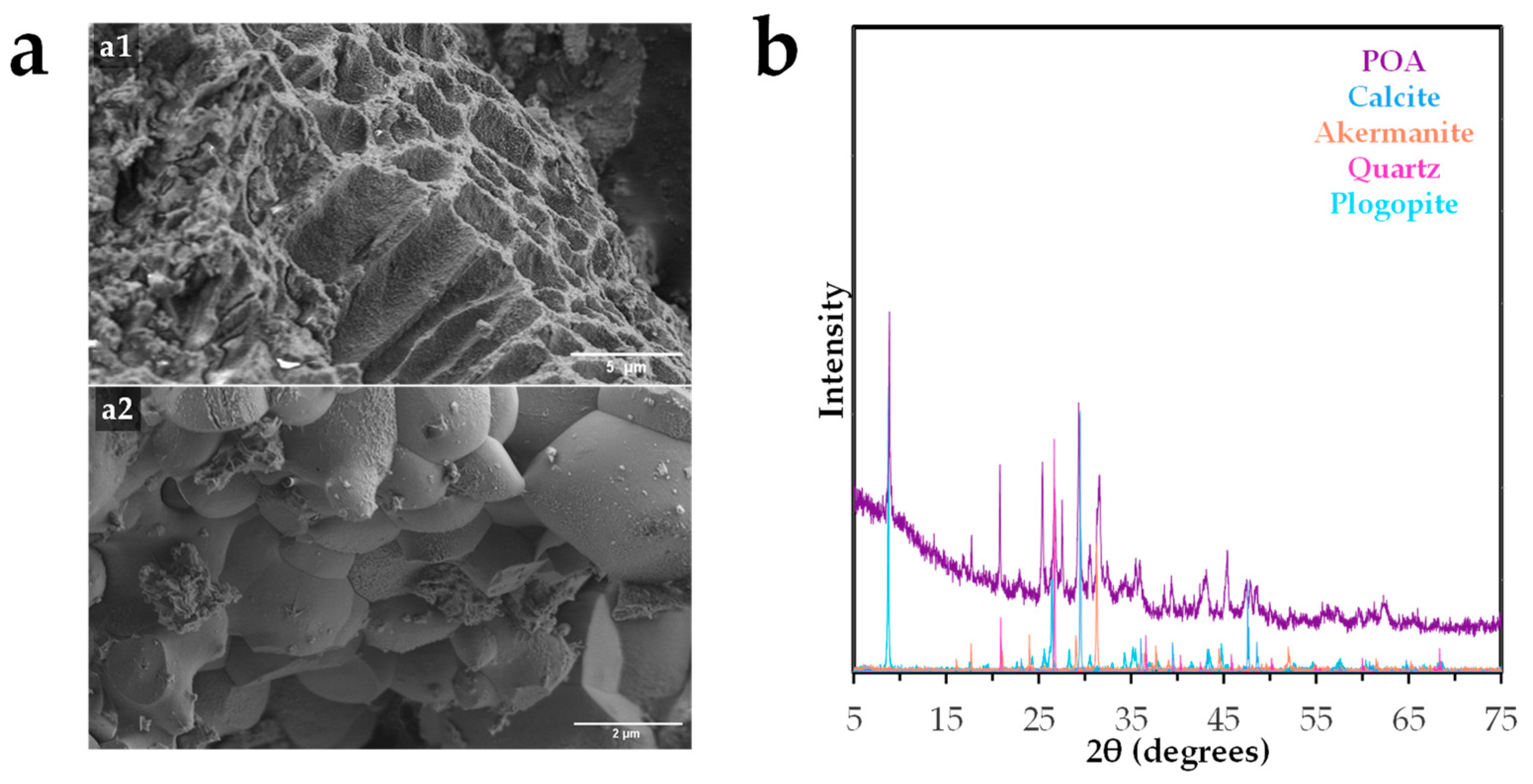
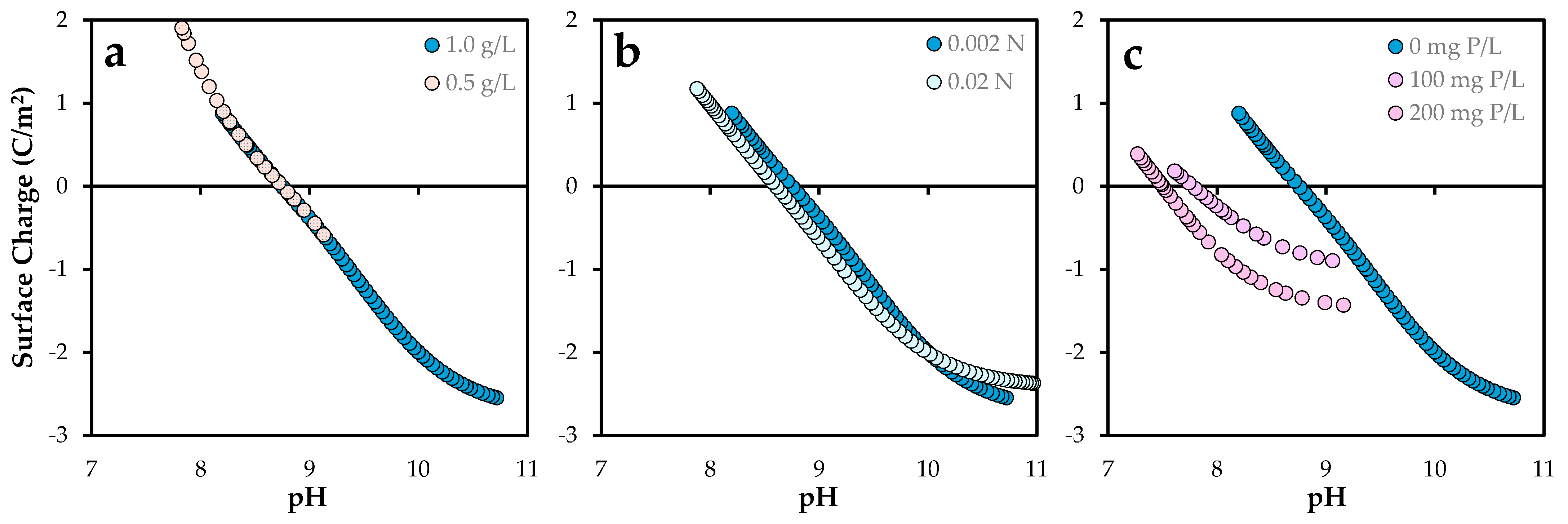

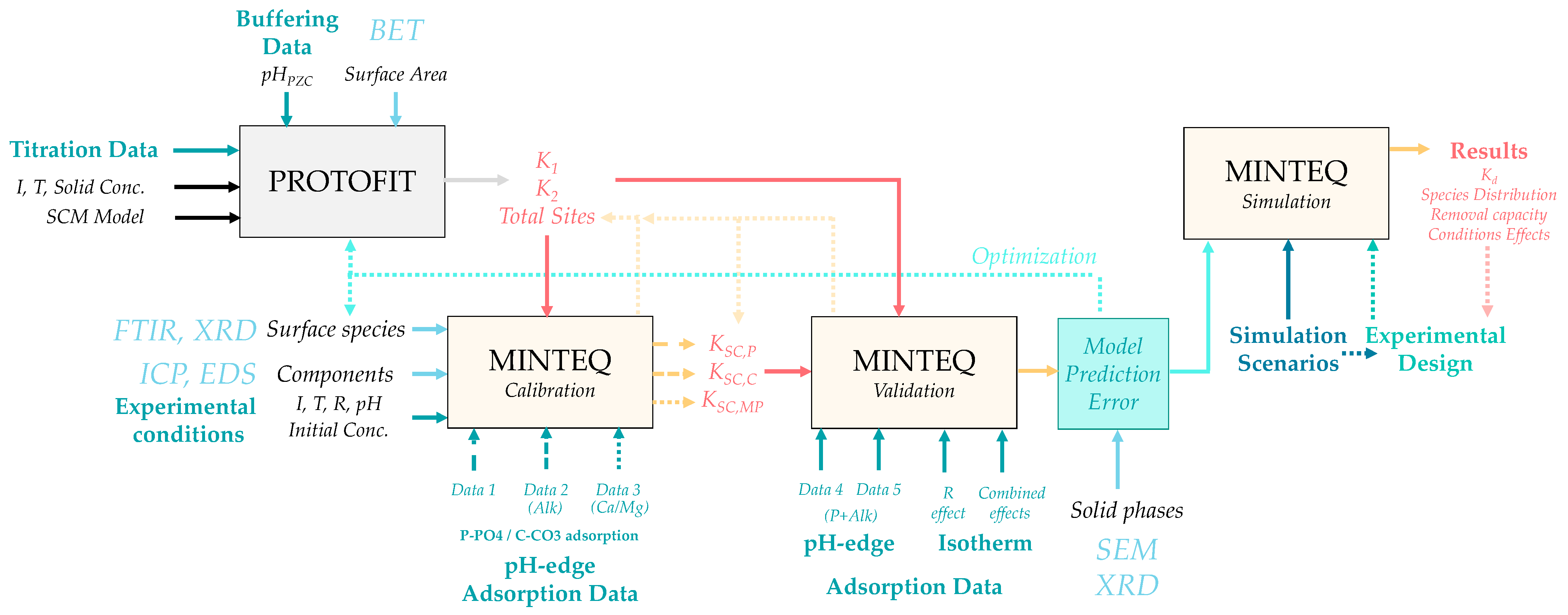
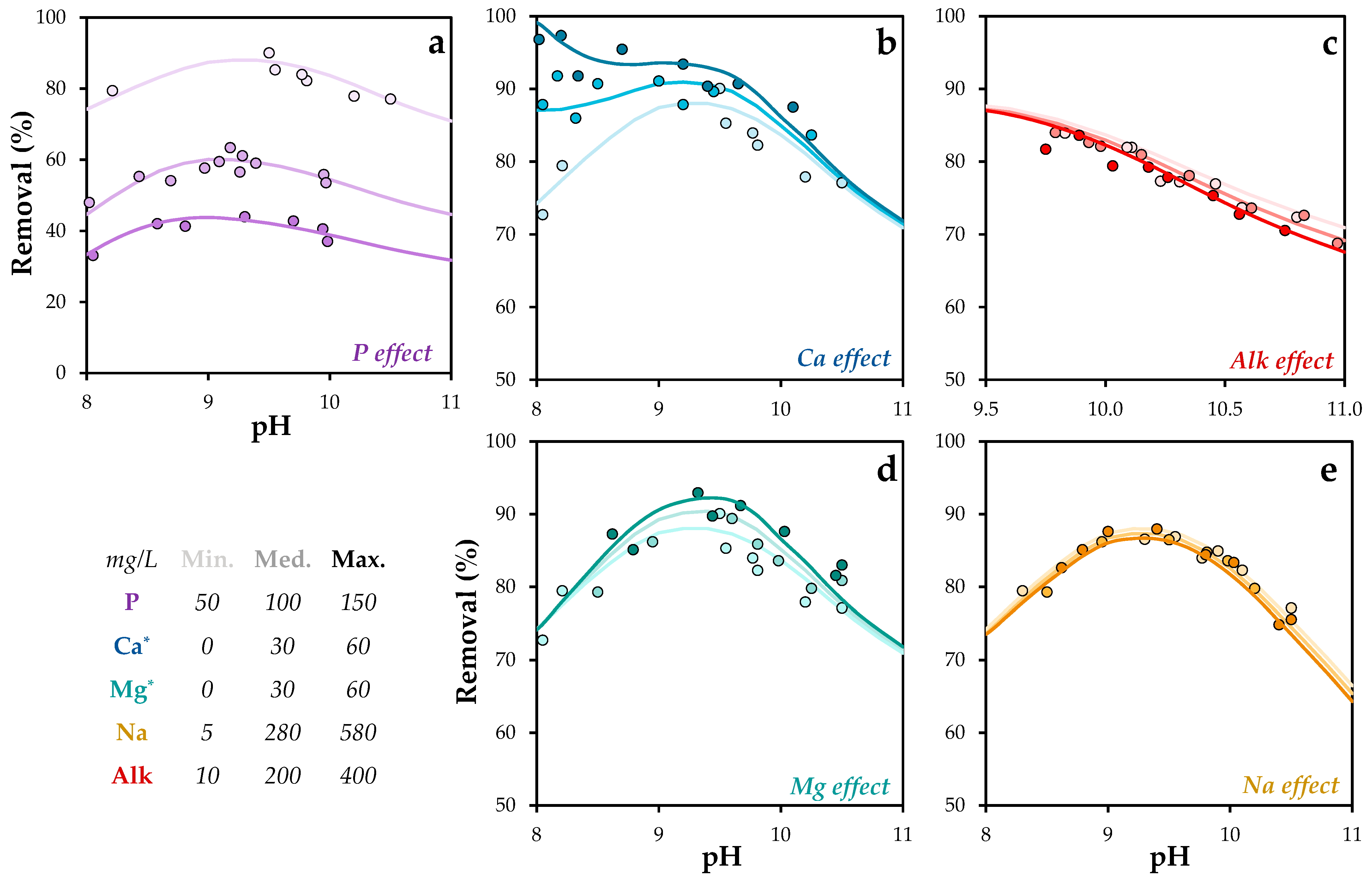



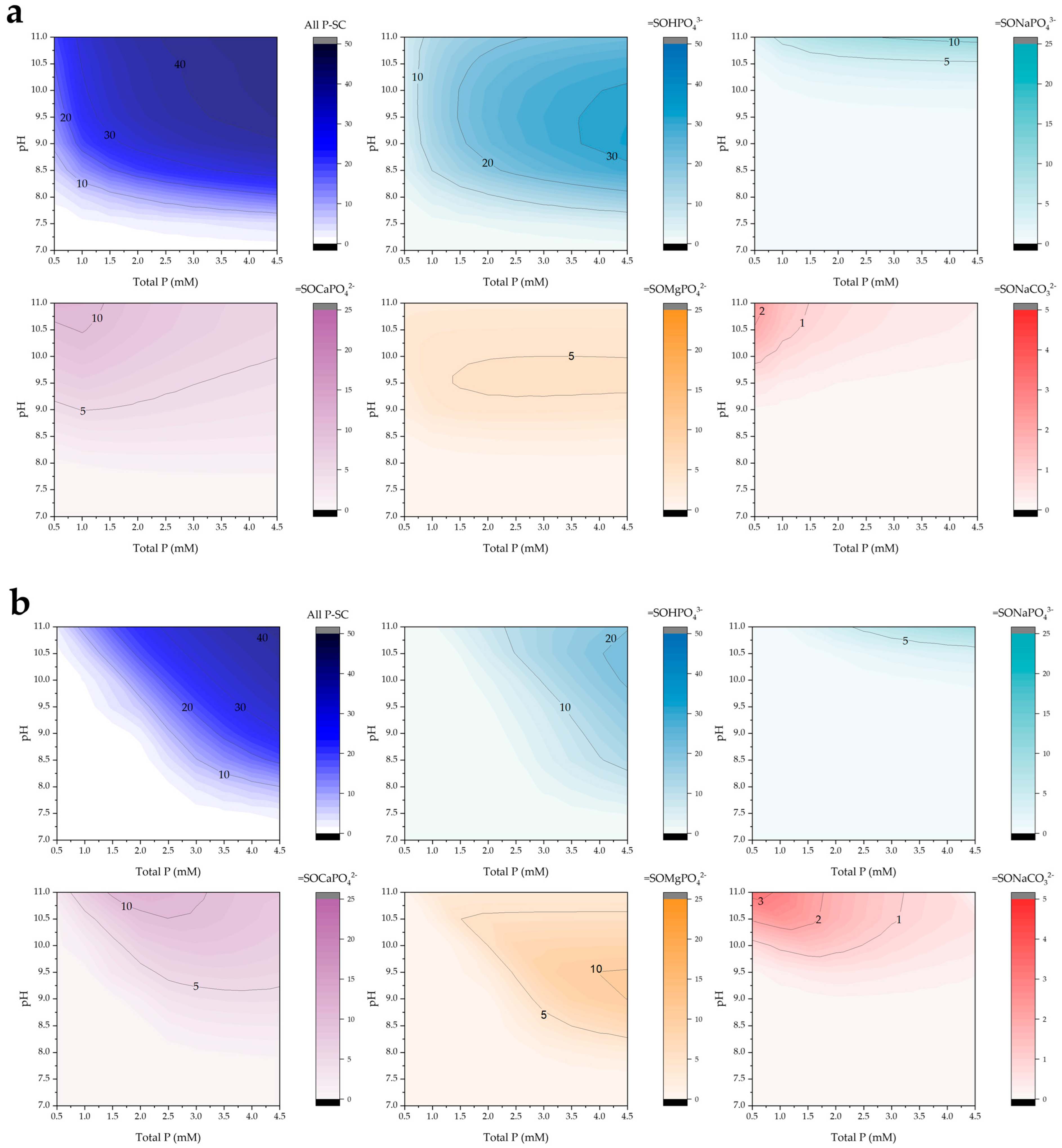



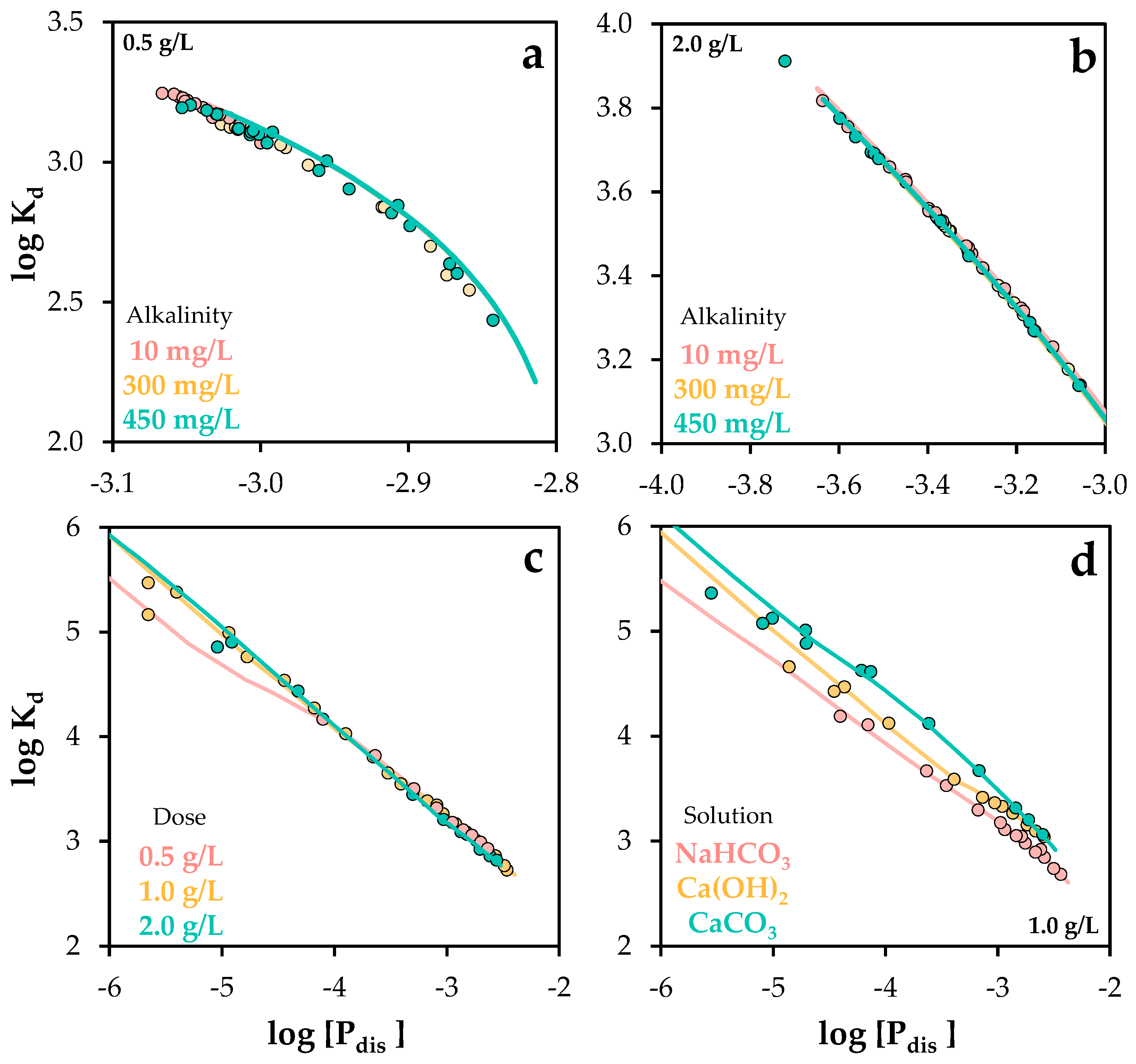
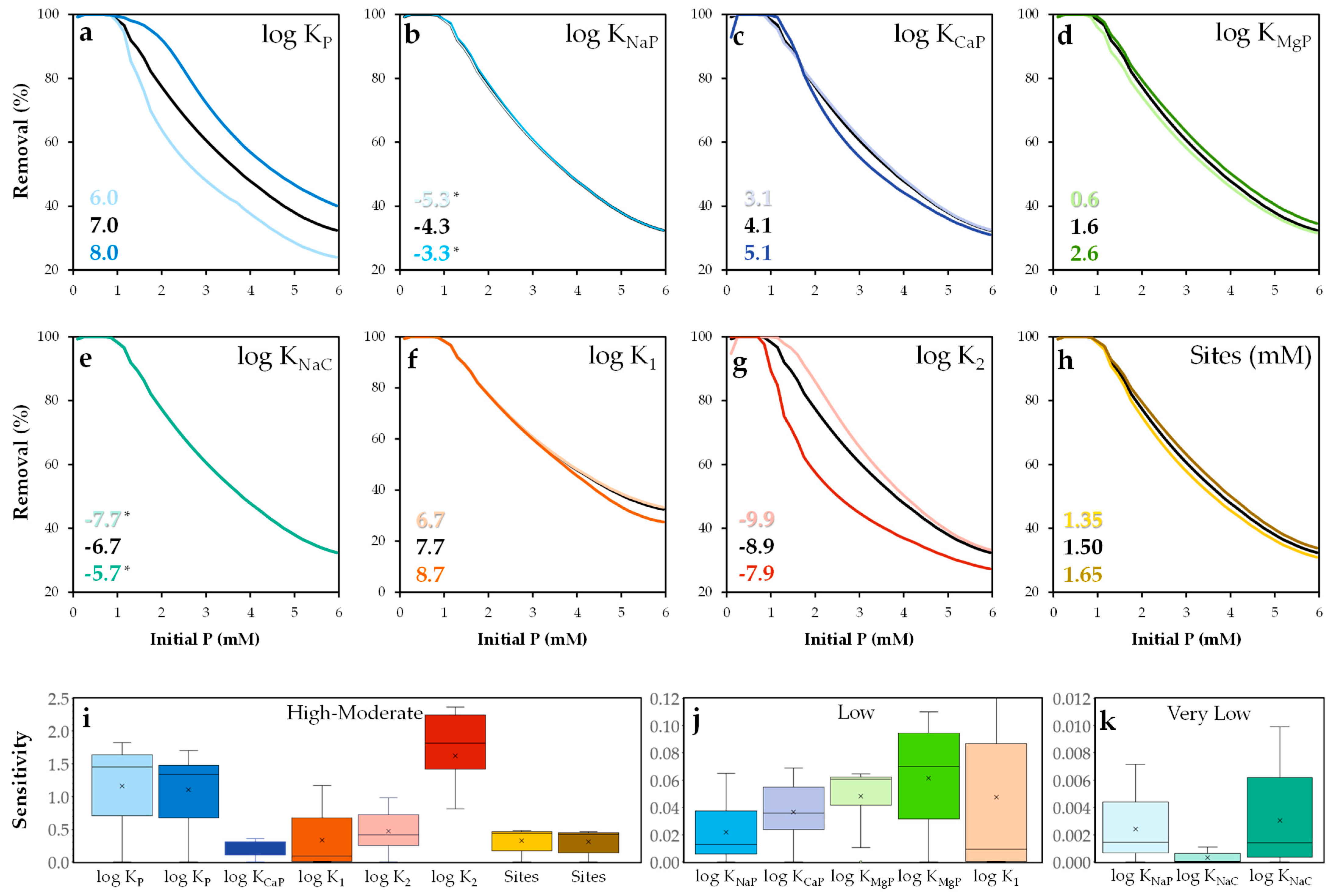
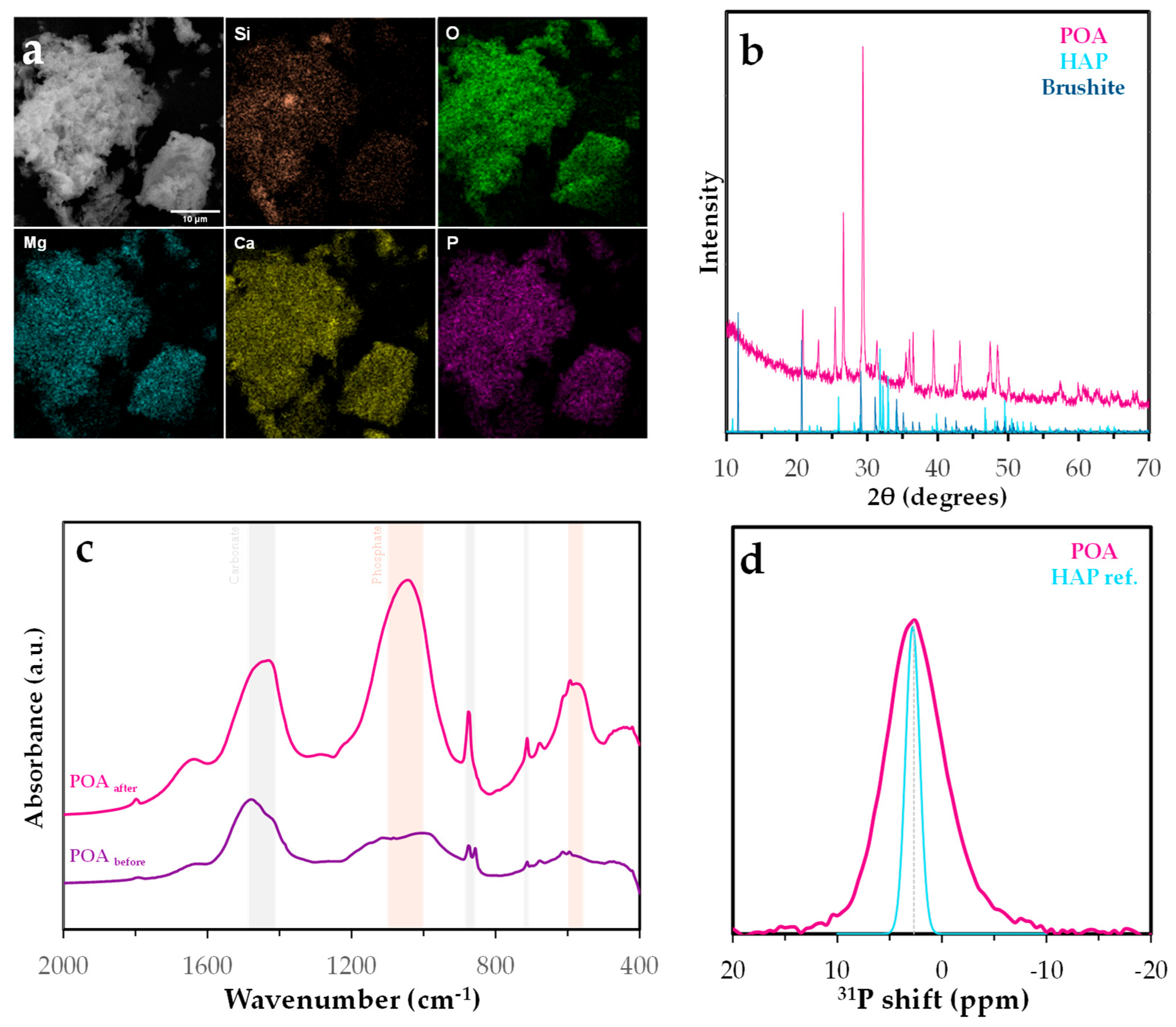
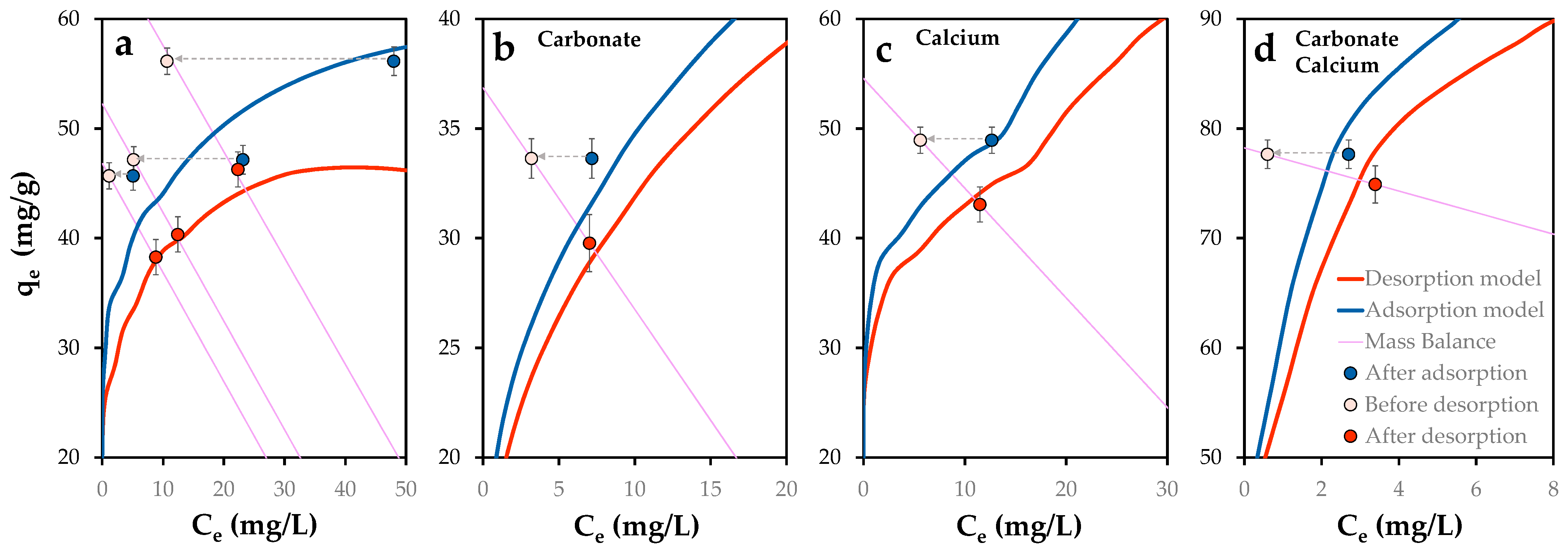
| Surface Properties | ||||
|---|---|---|---|---|
| BET Area | External Area | Micropore | pHPZC a | |
| (m2/g) | (%) | (cm3/g) | ||
| 13.25 | 86 | 0.00084 | 9.1 | |
| Elementary Analysis (wt. %) | ||||
| Carbon | Nitrogen | Hydrogen | Sulfur | |
| 3.42 | 0.01 | 0.48 | 1.85 | |
| Chemical Composition (wt. %) | ||||
| P2O5 | 0.39 | MgO | 8.44 | |
| SiO2 | 23.64 | K2O | 0.89 | |
| Al2O3 | 2.67 | Na2O | 1.62 | |
| Fe2O3 | 5.31 | CaO | 14.48 | |
| Precursor Material | Adsorbent | Dose (g/L) | q (mg/g) | Reference |
|---|---|---|---|---|
| Posidonia oceanica fiber | Raw | 10 | 3.0 a | [27] |
| K-clay, corn starch, and calcium oxide | Raw | 4 | 4.4 a | [28] |
| Posidonia oceanica fiber | Raw | 2 | 5.0 a | [29] |
| Sesame straw | Biochar | 2 | 9.4 b | [30] |
| Peanut shell | Biochar | 1 | 7.6 b | [31] |
| Municipal waste | Biochar | 1 | 13.1 a | [32] |
| Maize straw | Biochar | 100 | 9.5 b | [33] |
| Sewage sludge | Biochar | 1 | 15.2 a | [34] |
| Cocoa pod husk | Biochar | 5 | 5.8 a | [35] |
| Holm oak wood | Biochar | 1 | 4.1 b | [36] |
| Walnut shell | Biochar | 8 | 3.2 a | [37] |
| Walnut shell | Biochar | 2 | 6.4 b | [38] |
| Prosopis juliflora | AC | 4 | 6.7 b | [39] |
| Lignin | Magnetic AC | 6.7 | 21.2 b | [40] |
| Rice straw | Ash | 10 | 3.2 a | [41] |
| Reed | Ash | 2.5 | 14.7 a | [41] |
| Amine-functionalized rice husk | Ash | 0.6 | 13.4 b | [42] |
| Posidonia oceanica fiber | Ash | 0.5–2 | 33.5–58.7 a | This study |
| Components | ||||||||||
|---|---|---|---|---|---|---|---|---|---|---|
| Species | log K | CO32− | Ca2+ | H+ | H2O | K+ | Mg2+ | Na+ | PO43− | Si 1 |
| CaCO3 (aq) | 3.22 | 1 | 1 | 0 | 0 | 0 | 0 | 0 | 0 | 0 |
| CaH2PO4+ | 20.92 | 0 | 1 | 2 | 0 | 0 | 0 | 0 | 1 | 0 |
| CaHCO3+ | 11.43 | 1 | 1 | 1 | 0 | 0 | 0 | 0 | 0 | 0 |
| CaHPO4 (aq) | 15.04 | 0 | 1 | 1 | 0 | 0 | 0 | 0 | 1 | 0 |
| CaOH+ | −12.70 | 0 | 1 | −1 | 1 | 0 | 0 | 0 | 0 | 0 |
| CaPO4− | 6.46 | 0 | 1 | 0 | 0 | 0 | 0 | 0 | 1 | 0 |
| H2CO3 (aq) | 16.68 | 1 | 0 | 2 | 0 | 0 | 0 | 0 | 0 | 0 |
| H2PO4− | 19.57 | 0 | 0 | 2 | 0 | 0 | 0 | 0 | 1 | 0 |
| H2SiO42− | −23.04 | 0 | 0 | −2 | 0 | 0 | 0 | 0 | 0 | 1 |
| H3PO4 | 21.72 | 0 | 0 | 3 | 0 | 0 | 0 | 0 | 1 | 0 |
| H3SiO4− | −9.84 | 0 | 0 | −1 | 0 | 0 | 0 | 0 | 0 | 1 |
| HCO3− | 10.33 | 1 | 0 | 1 | 0 | 0 | 0 | 0 | 0 | 0 |
| HPO42− | 12.38 | 0 | 0 | 1 | 0 | 0 | 0 | 0 | 1 | 0 |
| K2HPO4 (aq) | 13.50 | 0 | 0 | 1 | 0 | 2 | 0 | 0 | 1 | 0 |
| K2PO4− | 2.26 | 0 | 0 | 0 | 0 | 2 | 0 | 0 | 1 | 0 |
| KH2PO4 (aq) | 19.87 | 0 | 0 | 2 | 0 | 1 | 0 | 0 | 1 | 0 |
| KHPO4− | 13.26 | 0 | 0 | 1 | 0 | 1 | 0 | 0 | 1 | 0 |
| KOH (aq) | −13.76 | 0 | 0 | −1 | 1 | 1 | 0 | 0 | 0 | 0 |
| KPO42− | 1.43 | 0 | 0 | 0 | 0 | 1 | 0 | 0 | 1 | 0 |
| Mg2CO32+ | 3.59 | 1 | 0 | 0 | 0 | 0 | 2 | 0 | 0 | 0 |
| MgCO3 (aq) | 2.92 | 1 | 0 | 0 | 0 | 0 | 1 | 0 | 0 | 0 |
| MgHCO3+ | 11.34 | 1 | 0 | 1 | 0 | 0 | 1 | 0 | 0 | 0 |
| MgHPO4 (aq) | 15.18 | 0 | 0 | 1 | 0 | 0 | 1 | 0 | 1 | 0 |
| MgOH+ | −11.42 | 0 | 0 | −1 | 1 | 0 | 1 | 0 | 0 | 0 |
| MgPO4− | 4.65 | 0 | 0 | 0 | 0 | 0 | 1 | 0 | 1 | 0 |
| Na2HPO4 (aq) | 13.32 | 0 | 0 | 1 | 0 | 0 | 0 | 2 | 1 | 0 |
| Na2PO4− | 2.59 | 0 | 0 | 0 | 0 | 0 | 0 | 2 | 1 | 0 |
| NaCO3− | 1.27 | 1 | 0 | 0 | 0 | 0 | 0 | 1 | 0 | 0 |
| NaH2PO4 (aq) | 19.87 | 0 | 0 | 2 | 0 | 0 | 0 | 1 | 1 | 0 |
| NaHCO3 (aq) | 10.03 | 1 | 0 | 1 | 0 | 0 | 0 | 1 | 0 | 0 |
| NaHPO4− | 13.45 | 0 | 0 | 1 | 0 | 0 | 0 | 1 | 1 | 0 |
| NaOH (aq) | −13.90 | 0 | 0 | −1 | 1 | 0 | 0 | 1 | 0 | 0 |
| NaPO42− | 1.43 | 0 | 0 | 0 | 0 | 0 | 0 | 1 | 1 | 0 |
| OH− | −14.00 | 0 | 0 | −1 | 1 | 0 | 0 | 0 | 0 | 0 |
| CO2 (g) | 18.16 | 1 | 0 | 2 | −1 | 0 | 0 | 0 | 0 | 0 |
| Surface Species | Ka | log K | =SOH | H+ | Ca2+ | Mg2+ | Na+ | PO43− | CO32− |
|---|---|---|---|---|---|---|---|---|---|
| Surface (de)protonation | |||||||||
| =SOH2+ | K1 | 7.7 | 1 | 1 | 0 | 0 | 0 | 0 | 0 |
| =SO− | K2 | −8.9 | 1 | −1 | 0 | 0 | 0 | 0 | 0 |
| Surface complexation | |||||||||
| =SOHPO43− | KP | 7.0 | 1 | 0 | 0 | 0 | 0 | 1 | 0 |
| =SONaPO43− | KNaP | −4.3 | 1 | −1 | 0 | 0 | 1 | 1 | 0 |
| =SOCaPO42− | KCaP | 4.1 | 1 | −1 | 1 | 0 | 0 | 1 | 0 |
| =SOMgPO42− | KMgP | 1.6 | 1 | −1 | 0 | 1 | 0 | 1 | 0 |
| =SONaCO32− | KNaC | −6.7 | 1 | −1 | 0 | 0 | 1 | 0 | 1 |
| Parameter | POA Before Adsorption | POA After Adsorption | ||||
|---|---|---|---|---|---|---|
| 1 | 2 | 3 | 4 | 5 | ||
| General | ||||||
| Solid Concentration (g/L) | 0.5 | 1.0 | 1.0 | 1.0 | 1.0 | |
| Ionic Strength (N) | 0.002 | 0.003 | 0.019 | 0.002 | 0.002 | |
| Initial P-PO4 (mg/L) | -- | -- | -- | 100 | 200 | |
| NEM Parameters | ||||||
| log K1 | 7.6 | 8.0 | 7.9 | 7.4 | 7.2 | |
| log K2 | −9.8 | −9.5 | −9.3 | −8.1 | −7.8 | |
| pHPZC (calculated) | 8.75 | 8.75 | 8.62 | 7.77 | 7.50 | |
| Sites Concentration (mM) | 0.9 | 1.7 | 2.8 | 1.2 | 1.1 | |
| Sites Density (mol/g) | 0.0018 | 0.0017 | 0.0028 | 0.0012 | 0.0011 | |
| Error Functions | ||||||
| RMSE | 0.0213 | 0.0317 | 0.0609 | 0.0152 | 0.0472 | |
| R2 Coefficient | 0.9969 | 0.9989 | 0.9961 | 0.9901 | 0.9812 | |
Disclaimer/Publisher’s Note: The statements, opinions and data contained in all publications are solely those of the individual author(s) and contributor(s) and not of MDPI and/or the editor(s). MDPI and/or the editor(s) disclaim responsibility for any injury to people or property resulting from any ideas, methods, instructions or products referred to in the content. |
© 2025 by the authors. Licensee MDPI, Basel, Switzerland. This article is an open access article distributed under the terms and conditions of the Creative Commons Attribution (CC BY) license (https://creativecommons.org/licenses/by/4.0/).
Share and Cite
Mengual, J.; González, J.A. Sustainable Valorization of Posidonia Waste Ash for Phosphate Removal: A Surface Complexation Approach Under Variable Water Chemistry. Molecules 2025, 30, 3639. https://doi.org/10.3390/molecules30173639
Mengual J, González JA. Sustainable Valorization of Posidonia Waste Ash for Phosphate Removal: A Surface Complexation Approach Under Variable Water Chemistry. Molecules. 2025; 30(17):3639. https://doi.org/10.3390/molecules30173639
Chicago/Turabian StyleMengual, Jesús, and Juan A. González. 2025. "Sustainable Valorization of Posidonia Waste Ash for Phosphate Removal: A Surface Complexation Approach Under Variable Water Chemistry" Molecules 30, no. 17: 3639. https://doi.org/10.3390/molecules30173639
APA StyleMengual, J., & González, J. A. (2025). Sustainable Valorization of Posidonia Waste Ash for Phosphate Removal: A Surface Complexation Approach Under Variable Water Chemistry. Molecules, 30(17), 3639. https://doi.org/10.3390/molecules30173639








